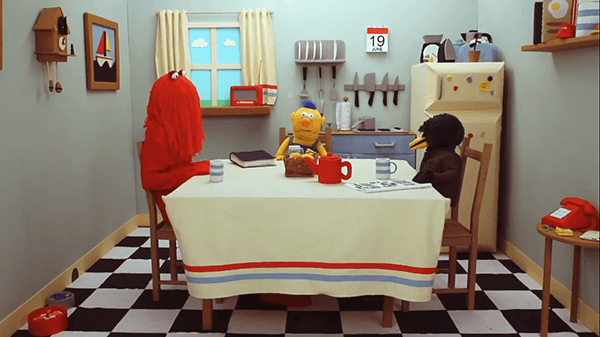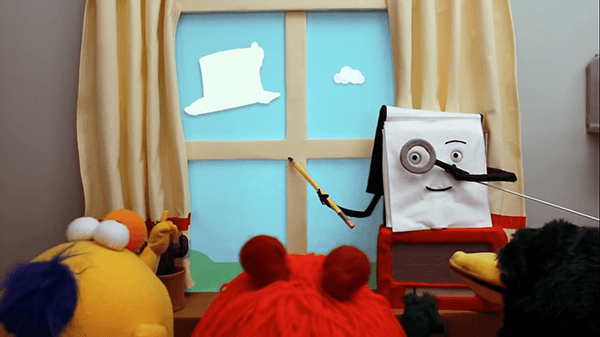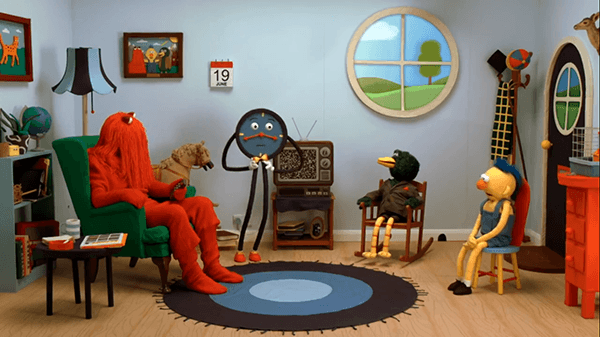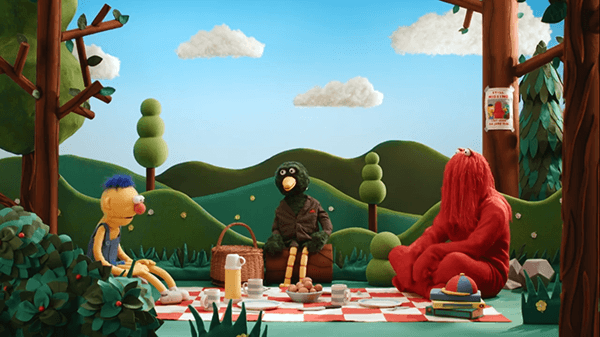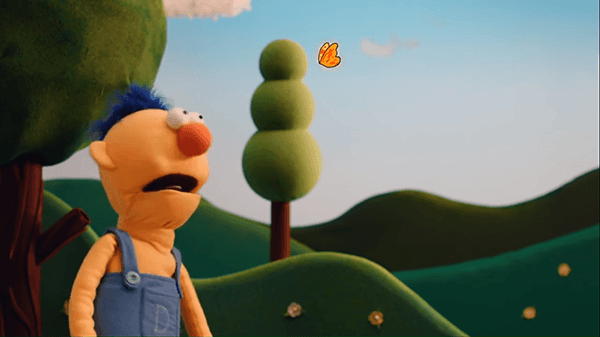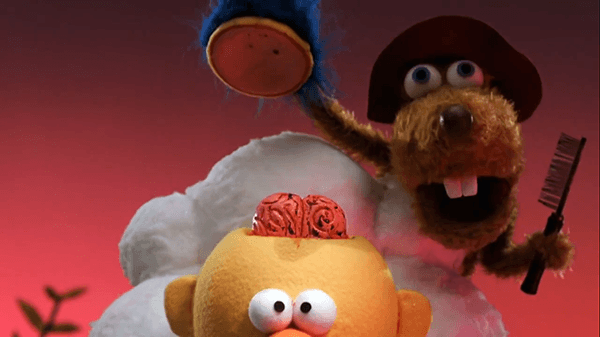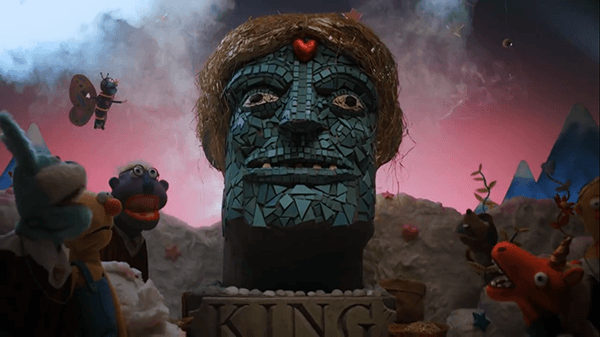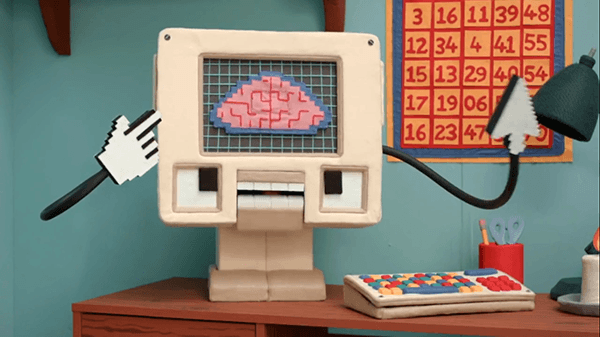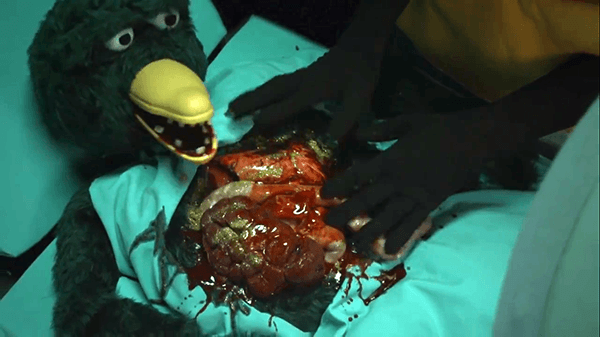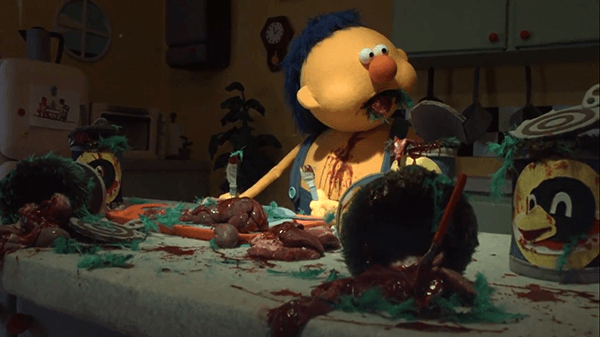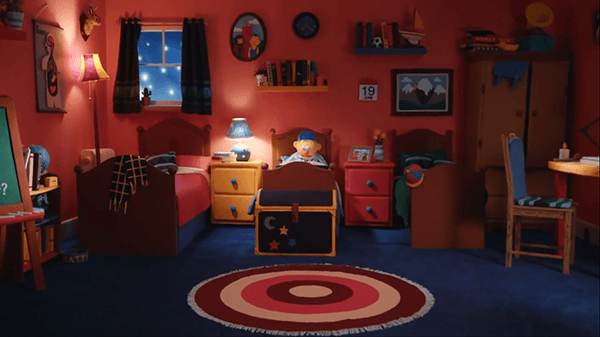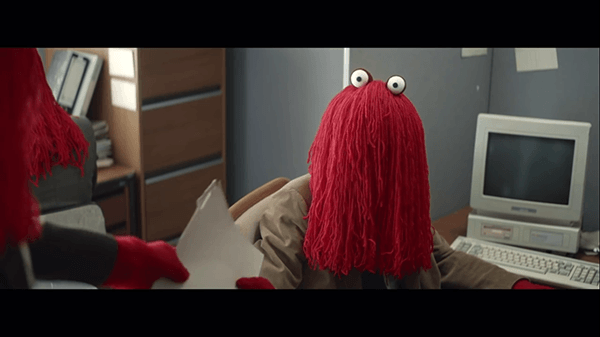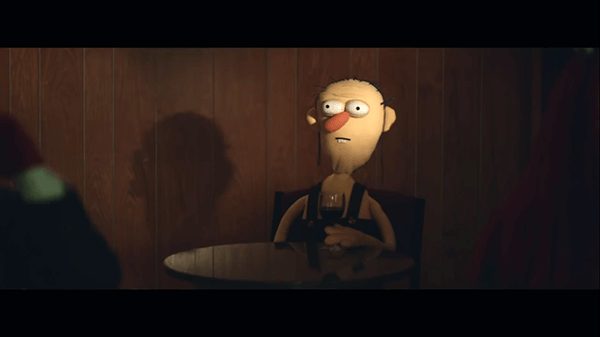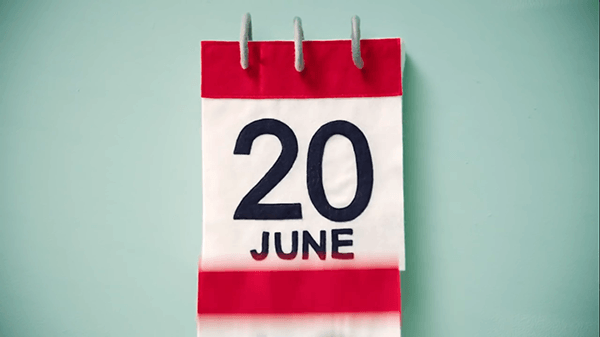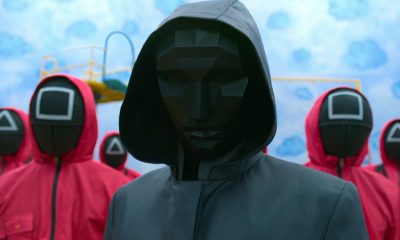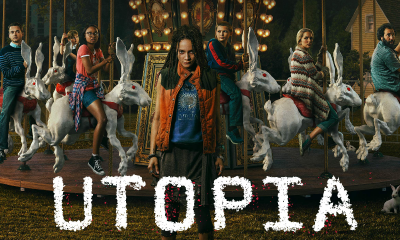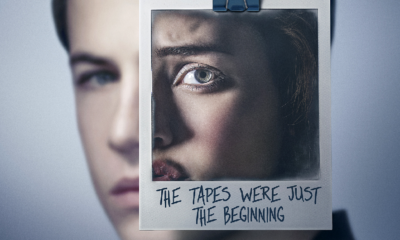Movies and TV
The Sinister Meaning of “Don’t Hug Me I’m Scared”
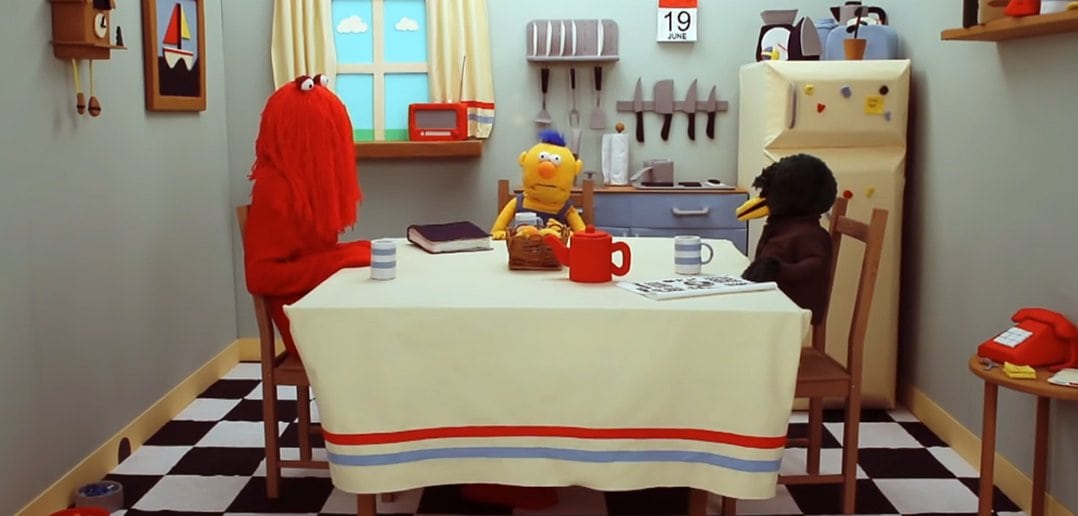
“Don’t Hug Me I’m Scared” is a web series of six enigmatic videos that has grown into a “cult phenomenon”. Behind the weirdness, however, is a deeper message: It is about mass media brainwashing and MKULTRA.
Over the last few years, I’ve received quite a few e-mails regarding Don’t Hug Me I’m Scared, a web series involving puppets and a whole lot of creepiness. VC readers astutely identified symbols and messages in the videos that pointed towards a deeper and more disturbing meaning. Now that the final video has been published and the story is complete, I can wholeheartedly agree with these readers: Don’t Hug Me I’m Scared is not merely about random creepiness. It conceals a message about the effects of mass media on the world, how it shapes and molds people’s opinions, and how it preys deliberately on young, impressionable minds. Even more disturbing, it also depicts the manipulation of agents working in the media using actual MKULTRA brainwashing techniques until they are completely broken down. Pretty heavy stuff for a show about puppets.
The videos were created by British artists Becky Sloan and Joseph Pelling in 2011. Each episode is made to appear like a typical children’s television program, consisting of singing and talking puppets similar to those of Sesame Street, but eventually, the story takes a dark turn, usually involving gore. The first episode was reportedly created with little to no budget. After the video gained popularity, a second video was commissioned by Channel 4, a British television station (note that this station also sponsored Viktoria Modesta’s “Prototype”, a music video that is full of MK symbolism – read my article about it here). The series then took off, with each episode going deeper into the depths of Monarch Programming (if you don’t know what that is, please read this article first). More than simply satirizing children’s shows, Don’t Hug Me I’m Scared paints a bleak picture of mass media and society as a whole. Let’s look at the episodes.
Episode 1
The first episode begins with the three protagonists of the show, Red Guy, Yellow Guy, and Duck Guy, sitting around a kitchen table. A few items shown in this scene will reappear throughout the series, notably the date of June 19th and the checkerboard pattern.
Then Sketchbook comes to life and explains to the friends how to “be creative”.
However, we quickly realize that there are strong contradictions in Sketchbook’s message.
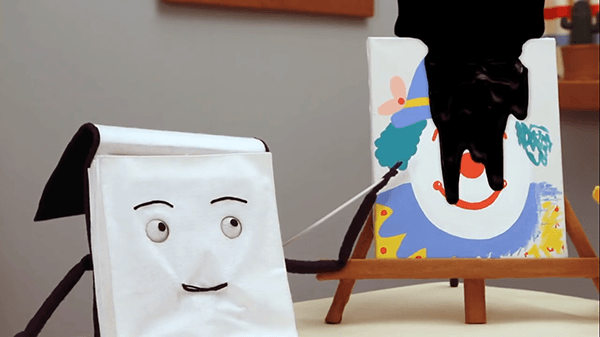
When Yellow Guy paints a picture of a clown, Sketchbook tells him “Hold down friend you might need to slow it down”. Then black paint slowly starts drips down the painting.
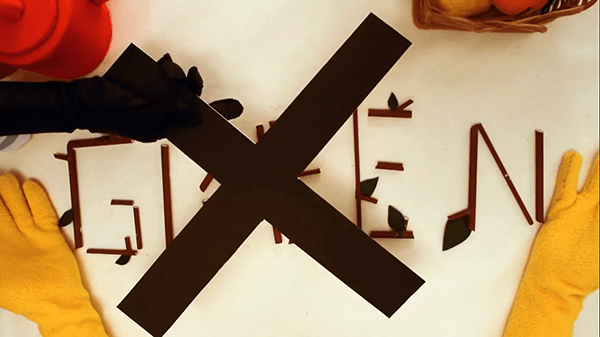
When asked for his favorite color, Yellow Guy writes green. Sketchbook denies his answer stating that “Green is not a creative color”.
When Sketchbook says: “Listen to your heart, listen to the rain, listen to the voices inside your brain”, things start to get dark.
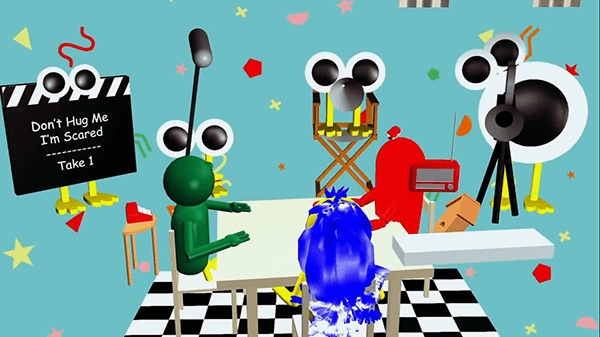
First, we see the camera showing the “behind the scenes” of the TV show, letting us know that the puppets are actually actors in a children’s TV show.
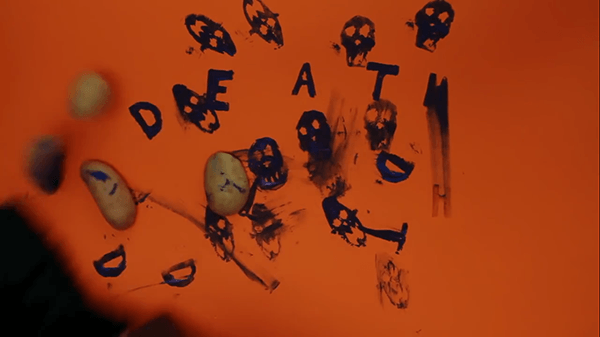
Then the puppets “get creative”, which means that they do a bunch of disturbing things and completely freak out.
This first episode, therefore, sets the stage for the rest of the series. It depicts three puppets being used somewhat unwillingly in a TV show that teaches unhealthy messages to children.
Episode 2
The second video is called TIME and features Tony the Talking Clock who teaches about the unstopping nature of time … and that everybody will be subjected to inevitable death and decay.
Although Tony the Talking Clock sings about time continually advancing forward, time is apparently still in the world of the puppets. Throughout the series, it is clear that it is always the same day.
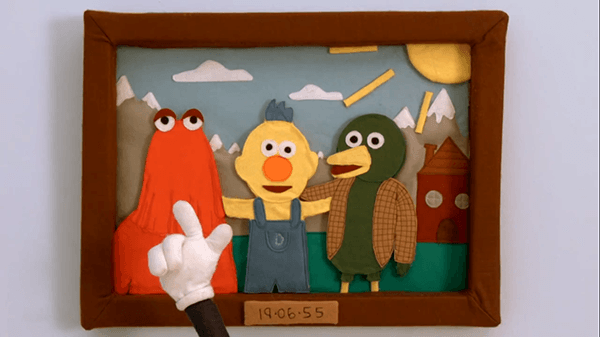
The clock points to a picture of the three friends. It is dated 19-06-55 (June 19, 1955), the “today” in each video.
The clock then takes the friends on a psychedelic journey through time from the past to the future.

Red Guy and Duck Guy are then seen with their brains connected to a giant computer topped by a giant eyeball. We are starting to understand that the puppets are under literal mind control. The pictures on the wall and the calendar imply that nothing is real in their minds.
It is during this episode that we first see Roy, Yellow Guy’s father. Every time we see him, an eerie music play in the background.
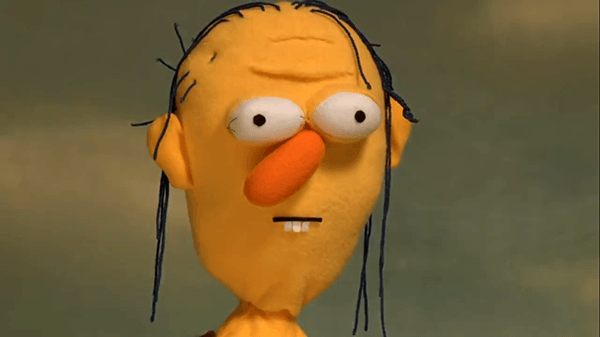
Yellow Guy’s father is the MK handler behind it all … and Yellow Guy will turn out to be the programmed slave.
In each episode, a “friendly” character pops out of nowhere to sing an educational song. But it always ends up showing its true face: Evil, sadistic and manipulative. In short, they are sent by the handler to program the puppets, who are then used to program TV viewers. Through hypnotic and subversive songs, the singing “friends” lure the puppets into a dissociative state where trauma awaits them.

The clock gets extremely angry when Duck Guy proposes an alternative definition of time. It also creepily watches on as time fast forwards and the puppets experience their own decay in real time.
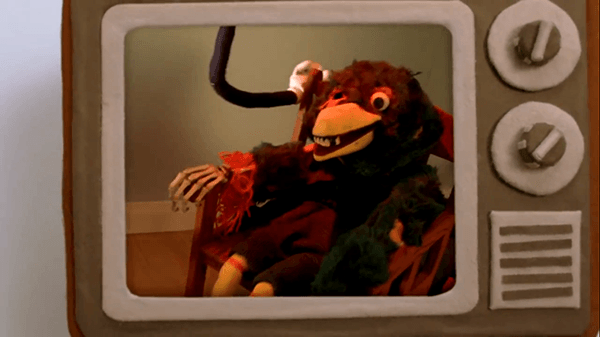
The puppets witness how their body will decay with time. In the world of MK, they are being subjected to trauma.
We then realize that this entire ordeal was all part of the friends’ TV show.
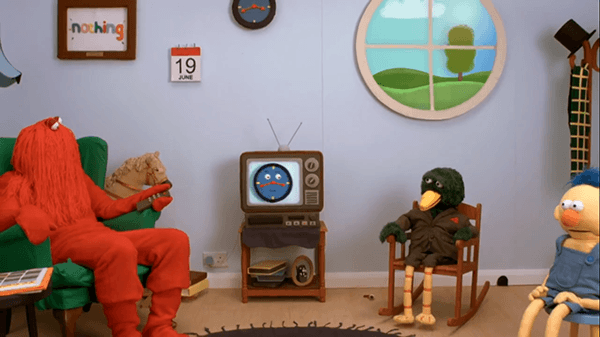
Tony the Talking Clock is on TV. As with MK programming, it is becoming difficult to distinguish between reality and fiction.
HELP
In the two short videos HELP and HELP #2, the puppets are held captive by assailants requesting money. Although this was primarily a way to promote the Don’t Hug Me I’m Scared Kickstarter campaign, the videos continued to reinforce the concept of the puppets as victims of trauma.
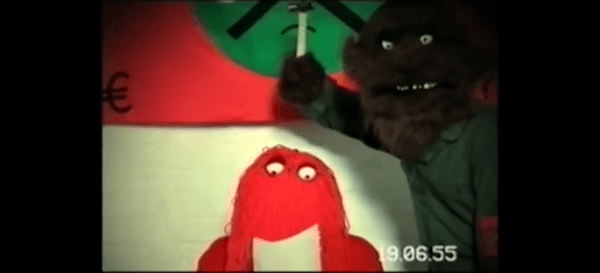
Red Guy is forced to read a memo under threat of being hit on the head with a hammer by an ISIS-ish monster. The date is still June 19, 1955.
Episode 3
The third installment of the series revolves around the concept of love and gets deeper into the concept of mind control.
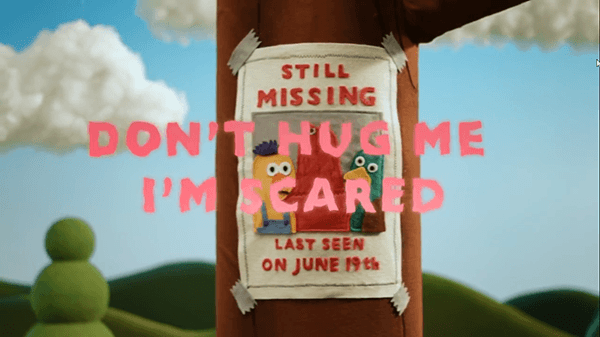
The video begins with a “Still Missing” sign featuring the three characters. They’ve been missing since June 19th … which is today.
As MK slaves, the puppets are literally “missing” from reality, where time stands still (despite what Tony the Talking Clock was singing about).
The puppets are sitting, once again, on a dualistic checkerboard pattern surface. In occult symbolism, the checkerboard pattern is the ritualistic surface on which profound transformation occurs. In mind control, these occult properties are used during programming.
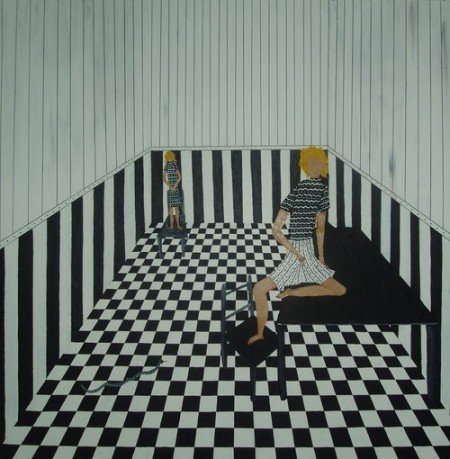
Several paintings by Kim Noble (a survivor of MKULTRA) prominently feature dualistic patterns. It is an integral part of mind control programming.
Then Yellow Guy sees something symbolic that indicates the beginning of programming.
As stated in multiple articles on this site, media that uses Monarch programming symbolism often indicates the beginning of a programming sequence with a butterfly that lures the slave into an alternate reality (such as in Pink’s Just Like Fire music video). In this case, the butterfly leads Yellow Guy to complete dissociation.
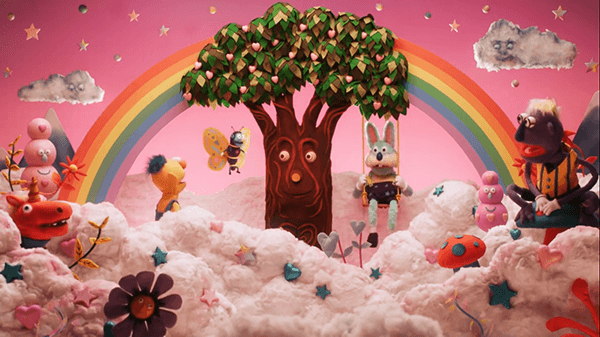
Yellow Guy literally goes “over the rainbow” (code for dissociation in Monarch mind control). The butterfly actually says “come on, just over the rainbow”.
In each video, the handler’s programming is represented by a cute character who leads the puppet to trauma. In the above image, Yellow Guy is literally in the clouds with strange characters and even a mushroom, which might imply that he is being drugged.
As usual, things turn dark and disturbing very quickly. Yellow Guy (who is not the sharpest tool in the shed) is tricked into believing that nobody will ever love him … unless he does what the butterfly says.
“This is your chance to start anew. And all we’re asking you to do is to is change your name, and clean your brain and forget about anything you ever knew.”
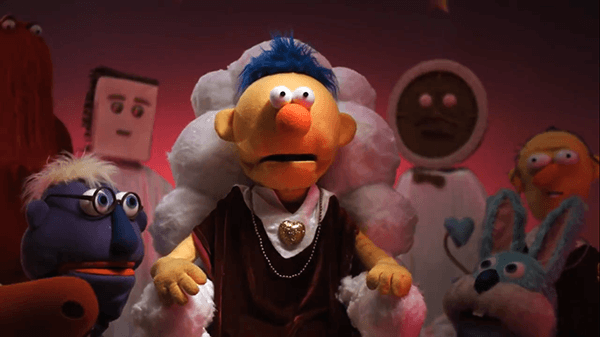
Behind Yellow Guy are Red Guy, Sketchbook, Tony the Talking Clock and, more importantly, his own dad, the handler behind it all. They are all witnessing his programming.
Like the rest of the series, this episode comments on how media forces specific ideas upon the viewers. The same way Yellow Guy is asked to worship Malcolm and to feed him gravel in order to find love, the masses are asked to worship stupid things and spend money to feel happy and loved. On a deeper level, the episode also depicts the actual mind control programming of Yellow Guy, the star of the TV show for kids.
Episode 4
Episode 4 begins with the three friends playing a board game. Once again, there are several subtle details that confirm the presence of programming.
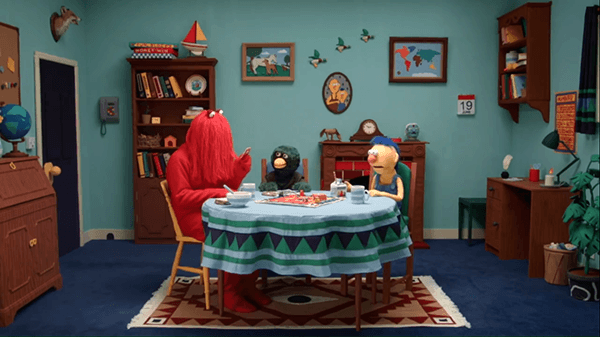
The friends are apparently inside Yellow Guy’s home – there is a picture of him and his father Roy (the handler) on the. Underneath the table, there’s a rug with an all-seeing eye in the center and four square “eyes” in each corner.
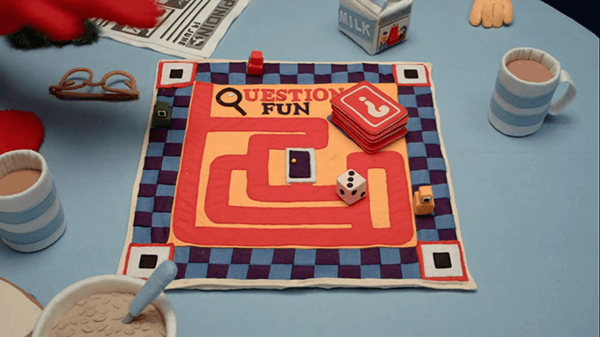
The same square “eyes” are found on their board game, combined with the all-important checkerboard pattern. They are still being programmed.
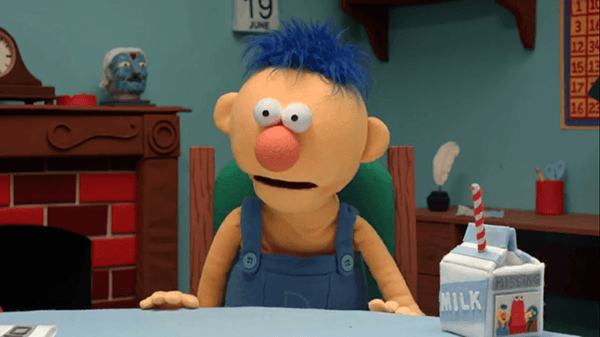
Behind Yellow Guy is the head of Malcolm the Love King illustrating that he has integrated this portion of his programming. Also, according to the milk carton, the three friends are still missing – even though they’re inside Yellow Guy’s house.
When a card from their game asks “What’s the biggest thing in the world”, the friends look at the globe. Studying the globe is indeed a great and wholesome way to learn about the real world. However, a slightly dumb computer interrupts their research.
Once again, we find here a comment about mass media. This TV show aimed at kids misleads them out of true information (learning from the globe) and lures them into learning pointless, big-brother-friendly information.
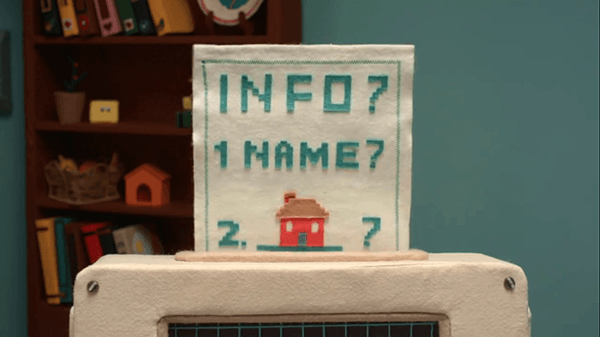
The computer starts asking all kinds of personal questions to the friends. This children’s TV show is attempting to normalize mass surveillance by presenting it to the viewers as something innocent and harmless.
When Red Guy tells the computer to “shut up” and taps on it, the friends are transported to the “digital world”. In MK terms, they are taken to dissociation. Once again, this symbolically represents them being programmed by their handlers.
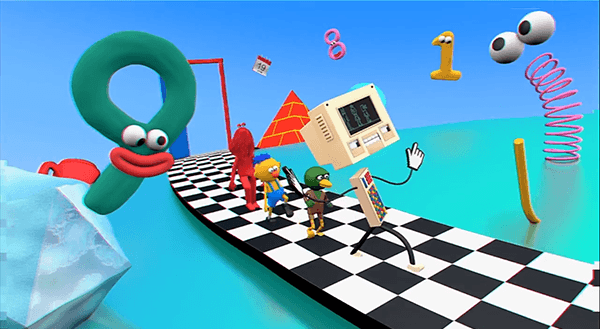
In the digital world, the friends follow a checkerboard pattern floor, implying they are following the programming script as laid out by the handler. A bunch of googly eyes and a pyramid appear in the background: basic occult elite imagery.
The show is not about teaching children about computers anymore: It is a confusing ordeal where the computer acts as an agent of the MK handler.
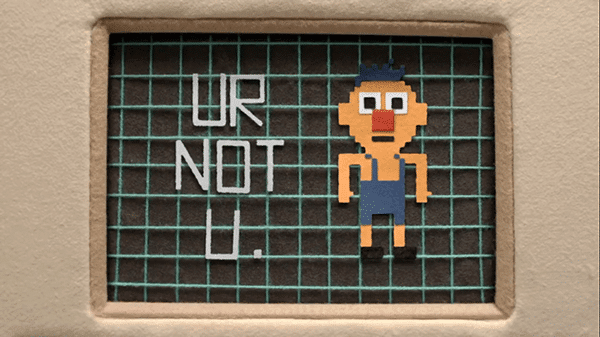
The computer symbolically represents what MK handlers do to their slaves: Removing them from their core persona through trauma and dissociation.
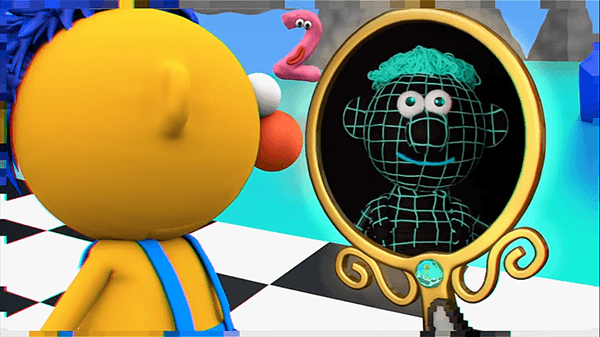
When looking into a mirror, Yellow Guy does not see himself, but a digital, “programmed” version of himself: his alter-persona.
As they get deeper into the digital world, the puppets find themselves inside a hypnotic whirlwind of sounds and images. Red Guy, the most critical guy in the group, gets sick of it and attempts to break out from programming.
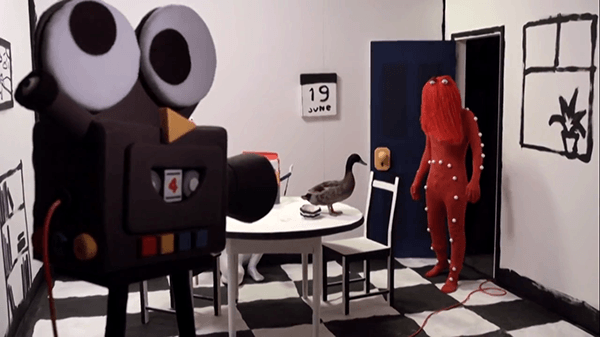
Red Guy finds himself in the “real world” (or a somewhat distorted version of it). He’s an actor in a children’s TV show that uses motion capture.
Red Guy is not supposed to be aware of this reality. And his head literally explodes. MK slaves cannot break from programming and, if they do, they are often programmed to “auto-destroy”.
Episode 5
Duck Guy and Yellow Guy are sitting in a kitchen and feel like something is “missing”.
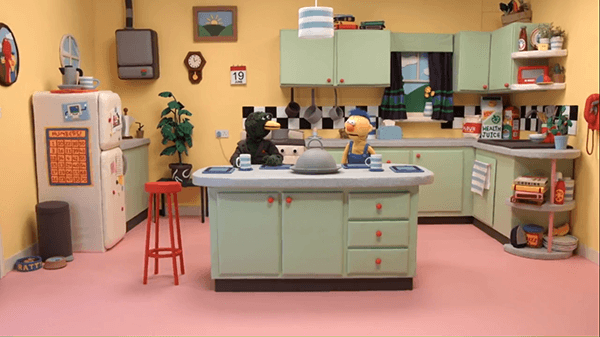
Duck Guy and Yellow Guy are too programmed to fully realize that Red Guy is gone. Notice Computer Guy on the fridge.
While looking around, the friends look at a picture on the fridge two separate times. The image is slightly different the second time around.
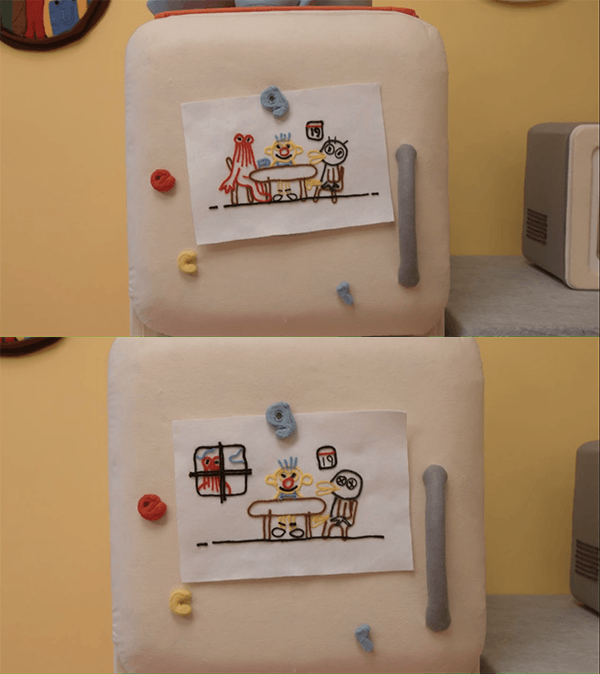
Upon second look, Red Guy is now outside the house, in the crosshairs of the window, and Duck Guy has Xs on his eyes. The image foretells something awful to come.
In this episode, food starts singing about healthy eating. As usual, they give terrible advice. During the song, a phone call interrupts everything.
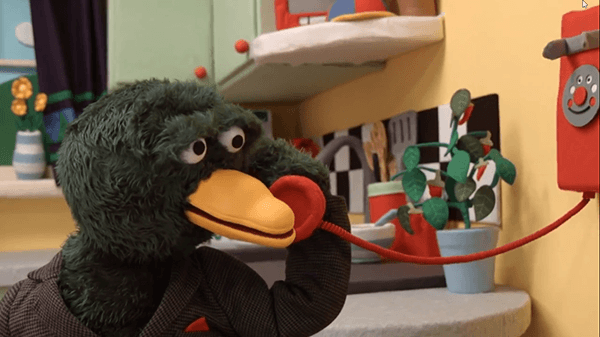
The red phone represents the link between the fake world of mass media and the grim reality of MKULTRA.
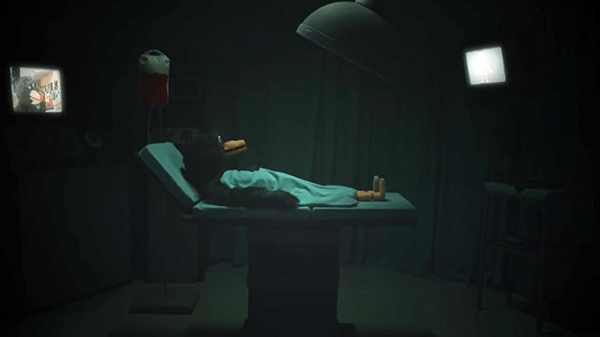
When he picks up the phone, Duck Guy finds himself in a dark surgical room. Judging by the monitor, he is in two places at once.
Meanwhile, a giant lamb chop sings about healthy eating. The song is confusing and full of contradictions, reminiscent of the mind games used by MK handlers to confuse and hypnotize MK slaves. Duck Guy cannot take this anymore and attempts to run away. He cannot go far.
It is at this point that we understand that Yellow Guy is the main focus of the MK programming. The other two were expendable – and probably not fully programmable. In this episode, Yellow Guy was exposed to extreme trauma: He was forced to lose his friend … and then eat him. He is being completely broken down so he can be reprogrammed.
Episode 6
In the sixth and final episode, things reach a disturbing conclusion.
At this point, we realize that the entire series basically took place in a single day. The first episode was during breakfast, then each episode progressed through the day until bedtime. But why did everything take place on June 19, 1955, specifically? Is there something significant about that particular day?
First, June 19, 1955, was Father’s Day, which gives things a sad tenor considering that the handler in the story is the boy’s father. Second, the year 1955 was during the post-war period, an expansive time for MKULTRA experimentation, as well as subliminal TV programming. In the present day, both of these fields have reached a very sophisticated and almost imperceptible level. (Fun fact: The final episode was released on June 19, 2016).
When Yellow Guy is finally ready to go to sleep, the lamp beside him comes to life and sings about dreams. Yellow Guy screams in horror because he knows that the song will inevitably turn into trauma. And he is right: He is back into his dissociative state.
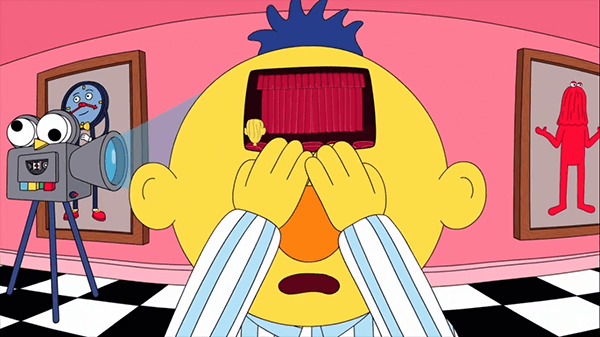
Back in dissociation (represented by a cartoon world), we see Yellow Guy’s mind being a show. Who’s in the audience? His father, the handler.
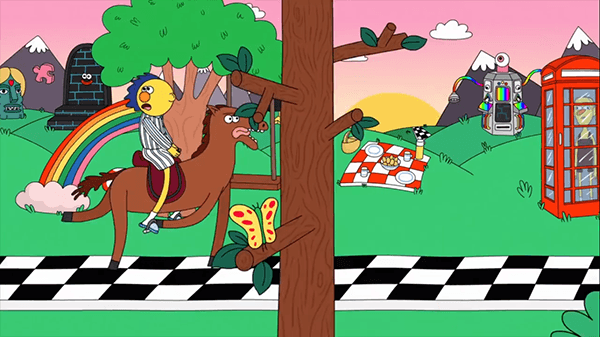
While following the ever-presented checkerboard road, Yellow Guy sees a butterfly (Monarch programming), a mushroom (drugs), the mind control machine topped by a giant eye, and, of course, his dad, the handler.
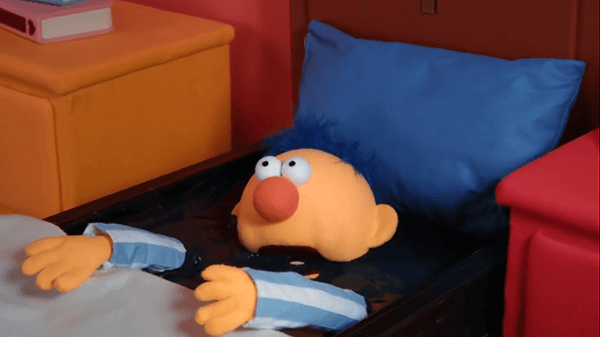
Yellow Guy’s “dream” turns into a nightmare as he drowns in black liquid (similar to what was poured on his painting in the first episode). Simulated drowning is a classic torture method in MK programming.
Meanwhile, Red Guy is apparently trying to live a normal life in the “real world”.
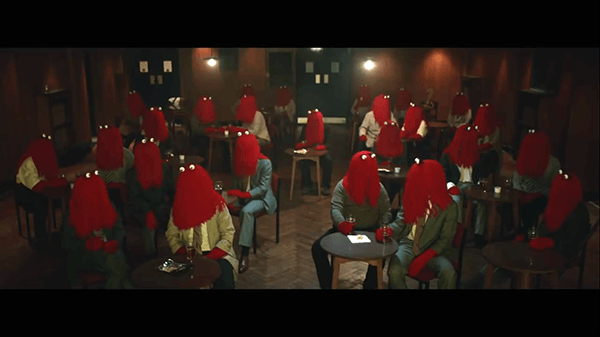
After work, Red Guy goes out and everybody looks the same. Are the makers of the series saying that the real world is populated by a bunch of conformist clones?
Red Guy gets on stage to perform for the crowd.
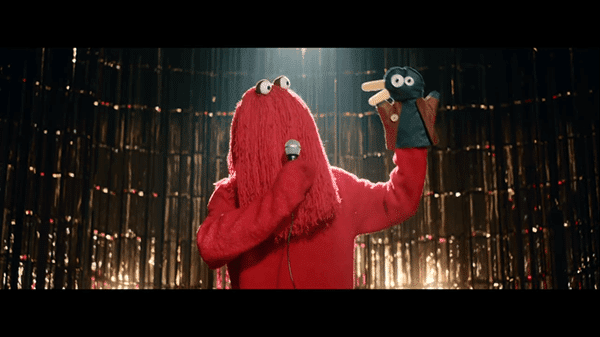
He sings the song about creativity heard in the first episode. He even replicates the parts sung by his friends. (RIP Duck Guy).
This scene is rather sad. It is basically an MK slave trying to express himself. However, all he knows is what he was programmed to know. So his “creative outlet” is to sing something he was forced to learn. Ironically enough, that song was about “creativity”.
Everybody in the crowd hates the song … except for maybe one person.
Roy has apparently found Red Guy to bring him back to his programming. MK slaves cannot be left loose in the real world for long.

Red Guy finds himself back in MKULTRA world. Was he ever in the “real world”? Was it all a dream? Reality and fiction is extremely blurry for MK slaves.
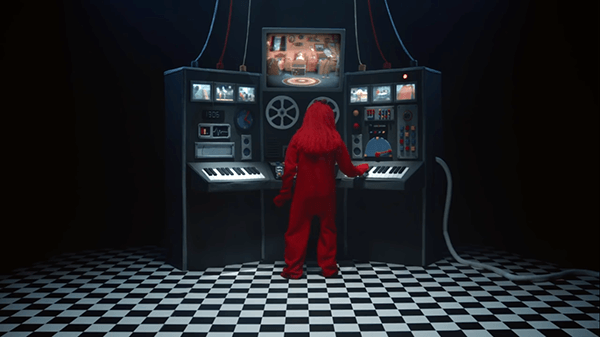
Red Guy finds the console that unleashes the singing things that are used to program the friends. Notice that there’s a video reel and a musical keyboard, hinting that music and video are used to control MK slaves and, on a wider scale, the masses.
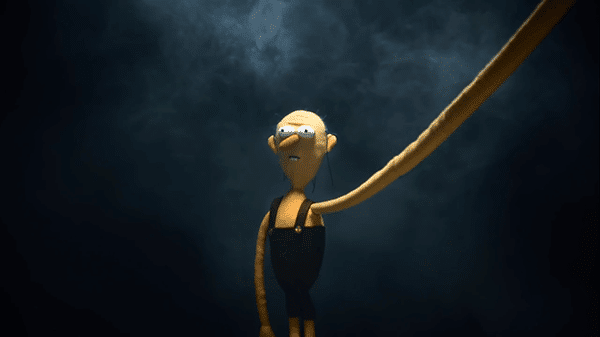
Roy the handler appears and attempts to reach Red Guy with an extremely long arm (the world of MK is very far reaching).
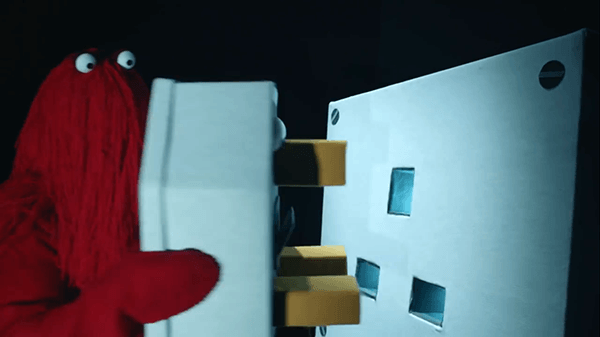
Red Guy unplugs the machine. Did he unplug himself from mind control? Did the masses unplug themselves from media control?
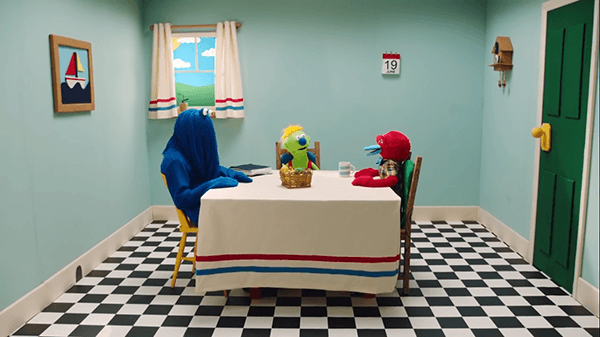
We then see the three friends sitting on a table, looking slightly different. They are in the colors mentioned in the first episode as their favorite color.
It’s a brand new day. Are these our friends? Are they free now? Not sure.
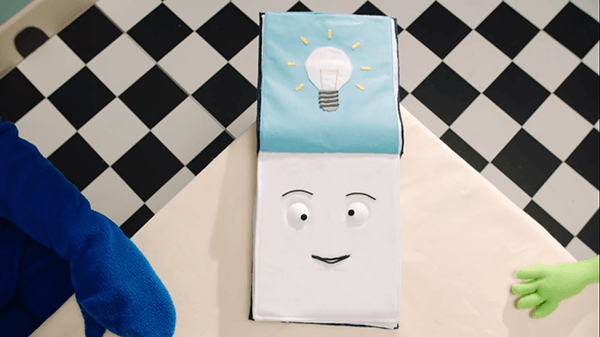
Sketchbook comes to life again, signing its song. Programming continues on the every present checkerboard pattern.
It’s the same story on a different day. For the kids watching the TV show, it is just another day of TV programming.
In Conclusion
Don’t Hug Me I’m Scared is a strange and disturbing adventure that has lent itself to all kinds of theories and interpretations. However, it is difficult to miss the series’ scathing commentary on mass media that targets young children and brainwashes them into conforming to the elite’s will.
Through symbolism, the series also comments on the most direct and brutal form of brainwashing: Monarch mind control, also known as MKULTRA. Indeed, the series puts on display the entire world of MKULTRA, from its distinctive symbolism to the horrific techniques used to cause trauma and dissociation. We are shown these techniques being used on actors, hinting that the people we know and love in our mass media might also be brainwashed MK slaves.
So is Don’t Hug Me I’m Scared a warning against the evils of mind control or does it simply propagate more of elite’s sick culture to the masses? The answer depends on whether or not you’ve pulled the plug from the machine.
- Hmm 🤔
- Donald Trump attends WEF conference in Davos (January 2020)
- 100% Proof Our Government is Hiding Nephilim Bodies & Are Trying to Bring Back Nimrod/Gilgamesh. Could Nimrod be the Beast of Revelation 17:8-11?
- Tesla's Elon Musk: We're 'Summoning the Demon' with Artificial Intelligence
- Lindsay Mills : Are you aware of occult symbolism in Her pictures..?!?
- LA Fire Attack Map is identical to the LA Smart City Rail Map
- Birds of a feather flock together …
Get an e-mail notification as soon as a new article is published on The Vigilant Citizen.
-

 Movies and TV2 months ago
Movies and TV2 months agoAdrenochrome and Ritual Humiliation: The True Meaning of the Movie “The Substance”
-

 Pics of the Month3 months ago
Pics of the Month3 months agoSymbolic Pics of the Month 10/24
-

 Latest News2 months ago
Latest News2 months agoKamala’s Campaign Was Objectively the Worst in Recent History
-
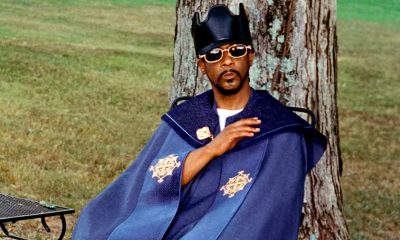
 Pics of the Month2 months ago
Pics of the Month2 months agoSymbolic Pics of the Month 12/24
-

 Latest News2 months ago
Latest News2 months agoWas the Jake Paul vs Mike Tyson Fight a Humiliation Ritual?
-

 Latest News3 months ago
Latest News3 months agoAn “Urban Opera” in Toulouse Using Massive Machines is Denounced as a Satanic Ritual
-
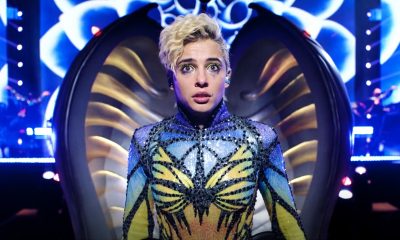
 Movies and TV1 month ago
Movies and TV1 month agoThe Hidden Meaning of “Smile 2”: It’s About Monarch Mind Control
-

 Latest News1 month ago
Latest News1 month agoIt Was Bound to Happen: Jay-Z Accused of Abusing a 13-Year-Old Girl
